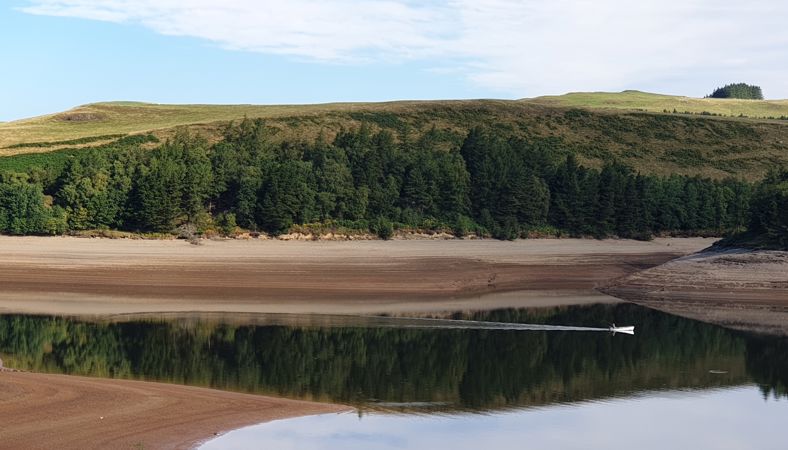All of Wales in drought status after months of dry weather

There is a pressing need to prepare and adapt to the environmental and wider impacts of climate change, Natural Resources Wales (NRW) said today (8 September) as it confirmed that all parts of Wales have now moved to drought status.
With the South West, South East and parts of Mid Wales already in drought, the Wales Drought Liaison Group met today to consider the latest hydrological and environmental data for North Wales and the impacts months of dry weather have had on the natural environment and people in the area.
Despite heavy rainfall in North Wales over recent days and weeks, is has not been sufficient to compensate for the impacts of the prolonged dry weather period over recent months.
NRW officers have taken the time to consider the effects of the rainfall on our waters and the local environment and there are significant concerns for the ecosystems and habitats, water supplies, land management and agriculture around the North East area, and in particular the Anglesey, Dee and Clwyd catchments.
This has led to senior representatives from NRW, Welsh Government, water companies and key representative groups to conclude today that the area should move from prolonged dry weather status to drought.
Natalie Hall, Sustainable Water Manager at Natural Resources Wales said:
“After a dry spring and summer, and the impact very little rain over a sustained period have had on our natural environment, we have taken the decision to move the whole of Wales into drought status.
“Rainfall experienced across the country over recent weeks has not been anywhere near enough to replenish rivers, groundwater or reservoirs to normal levels. We will need to see sustained or above average rainfall over the coming weeks and months to see any tangible difference. If we don’t see that rainfall, we can expect many areas to remain in drought.
“While essential water supplies remain safe, the public and businesses right across Wales areas are being urged to use water wisely and manage this precious resource at this time.”
Between March and August Wales received just 56.7% of its expected rainfall, the third driest six-month period since records began in 1865 (based on provisional data). In August alone, Wales received just 38% of its average monthly rainfall. The Met Office has also confirmed that this summer has been the eighth warmest for Wales since 1884.
The prolonged dry period has led to exceptionally low river flows, low groundwater levels and a decline in reservoir levels right across the country, with most well below average for the time of year. Wales has also seen higher temperatures in its waters and on land than expected for this time of year.
These conditions have exacerbated pressures on our land, habitats, species, wildlife and water supplies over recent weeks, leading to the first ‘official’ drought to be declared across Wales since 2005-2006*.
While sufficient rainfall over the autumn and winter months would go some way to replenishing rivers, lakes, groundwaters and reservoirs to normal levels by the spring, NRW will continue to work with Welsh Government, water companies and abstractors to ensure the needs of water users and the environment are met next year in the event of a dry autumn or winter.
NRW has been working closely with the Environment Agency (EA) in England in relation to cross-border environmental, water resources and navigational related impacts and to give careful consideration to any drought declarations in areas which span the England-Wales border.
NRW and the EA will be keeping these areas under close monitoring and discussing and agreeing any actions that need to be taken for these catchments.
Over the coming months, NRW will also sustain, and where necessary, step up its work to manage the impacts of drought and help balance the needs of water users and the environment across Wales. This includes:
- Working with water companies to ensure that they are taking actions in line with their statutory drought plans, and that they’re working to reduce water loss by stepping up work to fix leaks, reduce household demand and preparing for other drought measures as required.
- Monitoring river flows, groundwater levels, fisheries and ecology and increasing the number of checks in important locations.
- Ensuring regulation schemes are operating to support abstractions and considering releases or other drought measures for the environment
- Ensuring abstractors are complying with their licence conditions, many of which restrict how much can be taken during low flow periods.
- Responding to environmental incidents and taking the appropriate enforcement action as required.
- Providing advice and guidance such as dry weather advice for farmers.
Natalie Hall added:
“Each drought is different in its extent, severity and impact. As such, it is difficult to predict when we will see the environment, our water supplies and the agricultural sector move into recovery.
“The impact of climate change and the likelihood of more frequent and more severe weather presents an ever-greater challenge for every part of society. As we continue to manage the environmental impacts of this drought, we will also ensure that we sustain and step up our own actions to and work with partners to make sure Wales is in the strongest possible position to manage any drought risk in 2023 and beyond.”
NRW is encouraging anyone to report environmental incidents to its 24-hour incident line on 0300 065 3000, or via the NRW website. For updates on NRW’s response to the drought, read our blog. For ways to save water, visit the Dŵr Cymru Welsh Water website. If you are in an area affected by drought, follow Public Health Wales advice on how to stay hydrated.
